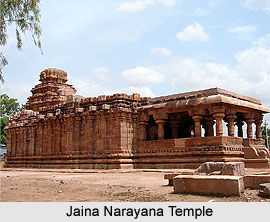 Jain temple of Pattadakal is an ancient site of architectural merit. It is a dravida vimana model. Originally dedicated to a Jain Tirthankaras, this Jinalaya locally known as the "Jaina Narayana" is raised on a characteristic high adhishthana. The exterior of the walls is symmetrically relieved into offsets mitigating to some degree the monotonous plain surface. In the Mukha-Mandapa rather unusually large is a bench with a back support all along the edge i.e. kakshasana. On the exterior side of the back support, in the upper zone are series of Ghata-Pallava an auspicious symbol of prosperity, humans, dwarfs, Sankhanidhi and the Padma-Nidhi symbolising wealth and prosperity, flanking the entrance and a few sculptural panels.
Jain temple of Pattadakal is an ancient site of architectural merit. It is a dravida vimana model. Originally dedicated to a Jain Tirthankaras, this Jinalaya locally known as the "Jaina Narayana" is raised on a characteristic high adhishthana. The exterior of the walls is symmetrically relieved into offsets mitigating to some degree the monotonous plain surface. In the Mukha-Mandapa rather unusually large is a bench with a back support all along the edge i.e. kakshasana. On the exterior side of the back support, in the upper zone are series of Ghata-Pallava an auspicious symbol of prosperity, humans, dwarfs, Sankhanidhi and the Padma-Nidhi symbolising wealth and prosperity, flanking the entrance and a few sculptural panels.
On the kakshasana at regular intervals are the circular pillars without base. In the interior, are fully developed pillars comprising from the bottom to the top moulded base (jantha), shaft (kanda), square block (Padma- Bandha), kalasa, heavy, prominent, circular cushion like kumbha, tulip shaped member and entablature (phalaka) up to corbels (potika or bodige), all plain.
The most attractive architectural part is the crocodile arch (Makara Torana) crowning the dvarabandha of the Garbha-Griha. The makaras have long floriated tails intricately carved. In the Garbha-Griha is now a small Lord Shiva linga interpolated in the later period probably sometime after the care and patronage to the Jinalaya dwindled.
During 2002-04 the temple was restored. The missing exterior wall of the pradakshina patha, part of the kakshasana, flight of steps in the front and cracks, were carefully dismantled and restored. From here one would move on by the road over a distance of one and a half kilometres, straight into the temple complex on the river bank.
However, to the right on the way one can view the ruins of a temple with pillars of the Sahha Mandapa and the sculpture of couchant Nandi in the front and a Shivalinga stylistically of the mid Rashtrakuta period. A little before the river bridge, from the road on the right is another north-south oriented side road. At the junction of these two roads one gets the most enchanting panoramic view of the whole temple complex with the open green lawn in the fore-ground. The sight is grand. The complex comprises nine temples near to one another in a row and from the north to south as follows:
1. Kadasiddhesvara
2. Jambulinga
3. Galaganatha
4. Chandrasekhara
5. San games vara
6. Kasi Visvesvara
7. Mallikarjuna
8. Virupaksha
9. Papanatha
Some 200 metres south of the Virupaksha temple is the picturesque sculpture of Papanatha temple.
On the southern side of the Sangamesvara and in front of the Mallikarjuna is an octagonal inscribed pillar set upon a square platform. The pillar carried atop a three pronged spear head that is missing and is originally therefore a trisect-stambha. Further, behind the Jambulingaand the Sangamesvara and in front of the Kashi Visvesvara and the Mallikarjuna temple is a series of small memorial shrines of varied proportions in different states of dilapidation.



















